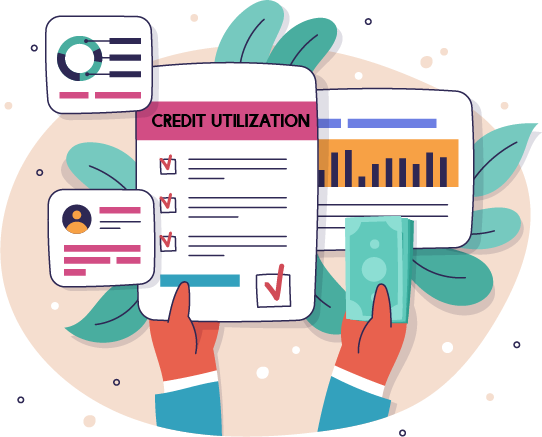

Did You Know?
We serve loans, the best way you can borrow

We serve loans, the best way you can borrow

Credit card debt has soared globally, raising concerns about probable defaults. According to studies, credit card defaults in India rose to Rs 4,072 crore at the end of March 2023. It shows lots of consumers are immersed in credit card debt traps, and it is because of rapid price increases. Now, with their dwindling savings, they have to forgo their future priorities and focus on settling their daily expenses. With that, it is now time we delve into the most important concept that directly impacts user's financial well-being: credit utilization.
Credit cards not only help you to buy your daily necessities but are also a significant factor in building your score. However, too much credit usage can reduce your score if you aren't careful. It feels great when you make good use of your credit. But creditworthiness is a challenging metric that requires caution and knowing how you are spending your balances and repaying them.
Continue reading this rundown to learn how credit utilization affects credit scores and how to maintain it low.
Credit utilization is the rate of how much credit you've used. It quantifies the amount of money on your revolving credit compared to the total credit limit. It alludes to the proportion the banks use in deciding your financial standing, which makes it an important variable used by credit reporting bureaus to calculate your score. The total credit utilization is determined by taking all your accessible credit, like loans, home value advances, contracts, and other obligations.
Example:
Person A has Rs 1000 in available credit with a balance of Rs 250. The utilization ratio will be (Rs. 250/Rs. 1000)*100%, which is 25%.
Person B has Rs 20,000 in the available credit with a balance of Rs 2,000. The utilization ratio will be (Rs. 2,000/Rs. 20,000) *100%, which equates to 10%.
From these examples, person A has a higher credit utilization ratio as compared to person B.
The higher the credit you have used compared to the accessible credit, the lower the utilization ratio, and the lower the utilization rate, the better. It is advisable to keep your credit utilization ratio below 30%. The rule of thumb is to utilize 10% of your available credit to maintain the required rate.
The most important trick here is that any lender can use your utilization rate to assess how much you spend compared to the available limits on your cards. It shows the spending habits of a user, which will determine whether you can qualify for a loan or not.
The credit utilization ratio is a metric showing how much credit you have used compared to your card limits. It is a key factor affecting the borrower's financial assessment. Having a higher amount on a card will hurt the credit score. But if you have paid it off and the report updates, it will help improve the credit score. This implies that if your credit card shows a high amount for a short timeframe, it won't bring long-term harm, but still, it is important to keep the credit usage ratio as low as possible.
Credit experts suggest keeping the credit utilization ratio below 30% on all your cards. With a low utilization rate, the bank will assess you as a borrower who can use credit mindfully without too much dependence on it.
How does credit utilization affect your score? Credit utilization is the second-most important factor after credit history that affects a credit score. It accounts for 30%, that is, the amount of debt you have relative to the amount you can borrow, and it affects your financial assessments. Credit bureaus will use this ratio to assess the borrower's financial behavior and determine their creditworthiness.
High utilization rates can harm credit scores, while a low rate will help improve the credit score. A high ratio shows you heavily rely on credit cards and is seen as a red flag by lenders. Conversely, a lower utilization ratio shows good credit management, which will enhance your score.
Using your credit card frequently will lead to a good utilization ratio that will harm your credit score. Therefore, keeping it low is the only way to make sure you are on the right track financially. Making sure you pay your balances in full and manage your obligations carefully will help you further develop these scores. The major element in the credit score is the credit history and how you make your payments over time. That's why late payments will also affect your score.
Ultimately, credit utilization affects the credit score either negatively or positively, depending on how you use your credit. The lower the utilization ratio, the greater the credit score, and vice versa. Therefore, strive to keep your credit usage rate as low as possible to be on the right track.
Though it is ideal to maintain lower credit utilization, users need to ensure it's not at 0%, as it would not help your score either. Lenders will want to see your credit usage and effectively manage it.
Not using credit is not considered fiscal responsibility. Let's explore ways to keep low the credit utilization ratio:
One of the best ways to lower the utilization ratio is to pay your card balances. But it is easier said than done. Believe it or not, each rupee you pay back reduces the utilization rate, which keeps you in a mutually beneficial state. Credit card debt will affect your credit utilization rate until you repay it. Paying the outstanding balances can greatly improve the score.
Not everyone can repay their card debts all at once, so do not be disheartened. Devise a repayment plan such that you set aside some funds to repay the balances monthly. Taking care of the balances also means paying the interest rate on the adjustments. You can then use the interest adjusted on the balances to pay the debt. You can then make a plan to pay back the cards in full every month.
Apart from paying your credit card balances every month, you can also consider taking out another credit card. With a balance transfer card, you can transfer and put together huge balances on a single credit card, which will make it easier to pay off your obligations. Some balance transfer cards offer 0% APR to help you take care of your credit balances with ease.
Furthermore, opening a balance transfer card will help you increase your credit since you are increasing your credit. This will help you lower your credit utilization ratio, as long as you do not make large purchases.
Asking for a limit increase for credit is probably a fail-safe plan to keep your utilization rate as low as possible. But you need to be cautious and be sure you do not have debt and are spending within your means. Most card issuer firms allow users to apply for an increase on credit lines anytime they want. Thanks to the internet, it takes a click of a button to start the application process. Normally, you will be required to provide your updated income details so that the lender can determine the limit you can get. When approved, the new limit will go into effect right away.
Getting a credit limit increase is an easier and faster way to lower your credit utilization ratio. But it comes with potential drawbacks.
First, the creditor will run a hard inquiry on your report before approval. Though it is rare, a hard pull reduces your credit score by a few points. Secondly, you need to be sure that you will spend your money wisely and keep the spending at its level. If not, you will increase your ratio, which isn't good for your score.
Another awesome strategy to reduce credit utilization is debt consolidation using a personal loan. Here, instead of using a credit card, you use a personal loan, which can finance major purchases. Unlike revolving credit, such as credit cards, personal loans are considered installment loans with fixed rates and a defined repayment plan. Transferring your pending debts to a loan will bring the utilization rate down only if you stop charging those credit card gains.
A ratio under 30 percent is considered good credit utilization. However, remember that this number could be better, so keep it as low as possible but not at zero. The lower the rate, the better the score.
No. A zero percent utilization ratio cannot help with your credit score since lenders assess your creditworthiness by looking at your card management.
You can freely drop card requests without necessarily harming your score. However, you need to settle the card balances without missing the payments. Shutting down a card will not affect your financial record.
Download our personal loan app to apply for a personal loan. Get up to 2Lakhs* as a personal loan. Download Now!
Sign into avail a personal loan up to ₹ 2,50,000
Register to avail an instant loan in just a few minutes. Fulfil your financial needs with our loan and repay in easy EMIs.
Apply NowUnifinz Capital India Limited is a Non Banking Finance Company (NBFC) registered with the Reserve Bank of India (RBI). lendingplate is the brand name under which the company conducts its lending operations and specialises in meeting customer’s instant financial needs.
Corporate Identity No. (CIN)
L 1 7 1 1 1 D L 1 9 8 2 P L C 0 1 3 7 9 0
RBI Certificate of Registration No (CoR):
1 4 . 0 0 2 3 3
Registered Office :
Rajlok Building (Floor-5), 24 Nehru Place, New Delhi-110 019